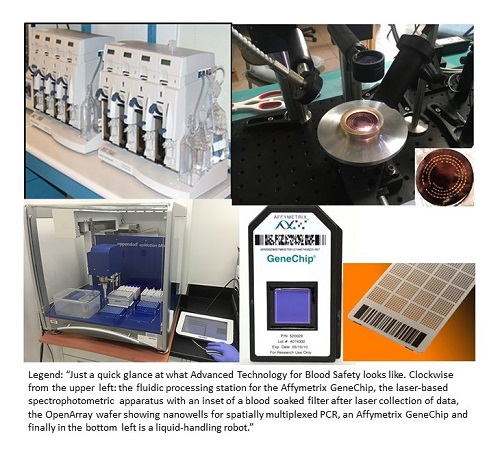Advanced Technology for Reducing the Risk of Transmission by Transfusion
Robert Duncan, PhD
Office of Blood Research and Review
Division of Emerging and Transfusion Transmitted Diseases
Laboratory of Emerging Pathogens
Biosketch
Robert C. Duncan received his PhD from the University of Maryland and performed post-doctoral research at the National Cancer Institute. He is currently a senior investigator and reviewer at the FDA Center for Biologics Evaluation and Research (CBER). His broad experience includes over 25 years of research encompassing virology, bacteriology, parasitology, cell biology, and new technology for pathogen detection. He has published over 50 peer- reviewed papers in these fields. He has been assisted by a postdoctoral research fellow and a technician, who have contributed to the success of his research program.
Dr. Duncan is internationally recognized for his expertise in blood donor screening for protozoan parasites, having chaired FDA committees for product license review, written FDA policy documents, and served on World Health Organization standards committees.
His laboratory has completed a variety of significant projects, including 1) developing a Leishmania donovani genomic microarray; 2) using microarray technology to detect bioterror pathogens; 3) collaborating with Life Technologies, Corp. to develop a blood-borne pathogen detection device using the multiplex real-time PCR OpenArray platform; 4) designing and testing a blood-borne pathogen detection resequencing microarray; 5) directing a study entitled, “Methods to Generate Spiked Clinical Samples for Use in Studies to Support FDA Clearance of Diagnostics for Low Prevalence Pathogens,” at the request of NIAID; 6) using a custom resequencing microarray to monitor the genomic drift of Ebola virus; 7) collaborating with Creative LIBS Solutions, LLC to evaluate a device to detect pathogens in blood by analyzing the spectrum of light released after a laser pulse to the sample surface.
General Overview
The Office of Blood Research and Review (OBRR) performs regulatory evaluation of in vitro diagnostic devices used to screen donated blood for infectious microorganisms. Currently, this screening is done for only a few specific, pathogenic (disease-causing) microorganisms that public health officials consider the biggest threats to blood safety.
However, there are no donor screening tests for several other pathogens that are uncommon, are transmitted only at certain times of the year, or that occur only in certain areas of the country. Nonetheless these pathogens can be transmitted and cause sometimes fatal diseases following transfusion into vulnerable populations (newborns, the elderly, and those whose immune system is weak).
In addition, certain pathogens may acquire sufficient genetic changes that render them undetectable to existing tests licensed for screening donated blood. This would require modification of existing tests or addition of new ones to detect the genetically altered pathogens.
The solution to this growing threat to the blood supply lies in the combination of 1) recent advances in technologies for identifying the genetic makeup of cells and microorganisms; 2) "multiplex platforms" that incorporate such methods into devices that enable very rapid detection of several different pathogens simultaneously. These technologies might simplify routine donor screening of many pathogens, including those that have acquired variations.
To stay abreast of this developing technology and facilitate its advancement, the Division of Emerging and Transfusion Transmitted Diseases (DETTD) established a program of research and evaluation in the Laboratory of Emerging Pathogens (LEP).
The aim of the program is to enhance blood safety and availability by using new technologies and combinatorial approaches to detect known blood-borne pathogens. Therefore, this program addresses the following FDA Focus Areas of Regulatory Science a) Public Health Emergency Preparedness and Response b) Medical Countermeasures and Preparedness for Emerging Infectious Diseases and c) Technologies to Reduce Pathogen Contamination.
Scientific Overview
We use our expertise in -and access to blood-borne pathogens, to evaluate new platforms for detecting pathogen-spiked human blood and plasma specimens. Moreover, we leverage the equipment and expertise of outside companies through contracts and collaborations as the most cost-effective way to evaluate these new technologies. Platforms will undergo final testing using repository blood donor specimens.
The principal investigator has studied new pathogen detection technology since 2000 and has published studies on the use of advanced technology to detect blood-borne pathogens (a Leishmania donovani genomic microarray, a microarray for pathogen detection, PCR-based species identification, a multiplex real-time PCR platform, a resequencing microarray, and Laser Induced Breakdown Spectrum Analysis).
Our laboratory conceived of the OpenArray multiplex real time PCR platform project, optimized it with spiked specimens, and validated it with repository specimens of infected blood donors obtained from Creative Testing Solutions.
The laboratory also evaluated the TessArae Resequencing Pathogen Microarray for its potential in multiplex blood donor screening. The laboratory is independently evaluating a custom-designed Blood Borne Pathogen Resequencing Microarray (BBP-RMA, version 2) for improved identification of pathogens in blood. We also use the resequencing microarray technology in a novel approach to tracking genomic drift in the Ebola Virus with funding from the Medical Counter Measures Initiative. Our work has demonstrated genomic drift in cultured viruses that express the Ebola surface glycoprotein.
Next generation sequencing (NGS) with a nanopore device is being applied to blood-borne pathogen detection in comparison to other multiplex platforms. Remaining engaged with NGS technology is important as the diagnostic field looks to the NGS platform as the way of the future.
The laboratory has established and validated standardized methods for spiking rare pathogens in blood to create specimens for testing new diagnostic devices. The standardized methods have been published and posted on the National Institute for Allergy and Infectious Diseases (NIAID) website for the use of device developers.
In addition, my laboratory participated in a collaboration with physicists in a research and development company who are testing a laser-based spectrophotometric device for detecting pathogens in blood. This multiplex technology tests a specimen without the need for sample preparation or traditional amplification methods. Successful results led to a publication, though re-direction of the company’s goals toward SARS-CoV-2 detection resulted in the termination of the collaboration.
The laboratory is collaborating with the Infectious Disease Next Generation Sequencing Diagnostic Sequencing Project by providing DNA samples extracted from well-characterized lab cultured pathogens. This CDRH project is building a database, called ARGOS, composed of sequences that are characterized well enough to be a resource for clinical molecular diagnostics.
Important Links
- ORCID ID: 0000-0001-8409-2501
Publications
- J Appl Microbiol 2022 Mar;132(3):2431-40
The use of laser-based diagnostics for the rapid identification of blood borne viruses in human plasma samples.
Multari RA, Cremers DA, Nelson A, Fisher C, Karimi Z, Young S, Green V, Williamson P, Duncan R - PLoS One 2022 Feb 10;17(2):e0263732
Tracking ebolavirus genomic drift with a resequencing microarray.
Tiper I, Kourout M, Fisher C, Konduru K, Purkayastha A, Kaplan G, Duncan R - PLoS Negl Trop Dis 2020 Feb 28;14(2):e0008050
CpG ODN D35 improves the response to abbreviated low-dose pentavalent antimonial treatment in non-human primate model of cutaneous leishmaniasis.
Thacker SG, McWilliams IL, Bonnet B, Halie L, Beaucage S, Rachuri S, Dey R, Duncan R, Modabber F, Robinson S, Bilbe G, Arana B, Verthelyi D - Clin Infect Dis 2019 May 30;68(12):2036-44
Asymptomatic visceral leishmania infantum infection in U.S. soldiers deployed to Iraq.
Mody RM, Lakhal-Naouar I, Sherwood JE, Koles NL, Shaw D, Bigley D, Co EA, Copeland NK, Jagodzinski LL, Mukbel RM, Smiley R, Duncan RC, Kamhawi S, Jeronimo SMB, DeFraites RF, Aronson NE - J Appl Microbiol 2019 May;126(5):1606-17
The use of laser-based diagnostics for the rapid identification of infectious agents in human blood.
Multari RA, Cremers DA, Nelson A, Karimi Z, Young S, Fisher C, Duncan R - Expert Rev Mol Diagn 2019 Jan;19(1):15-25
Advances in multiplex nucleic acid diagnostics for blood-borne pathogens: promises and pitfalls--an update.
Duncan R, Grigorenko E, Fisher C, Hockman D, Lanning B - Biochim Biophys Acta 2018 Aug;1865(8):1148-59
A novel signal sequence negative multimeric glycosomal protein required for cell cycle progression of Leishmania donovani parasites.
Ahuja K, Beg MA, Sharma R, Saxena A, Naqvi N, Puri N, Rai PK, Chaudhury A, Duncan R, Salotra P, Nakhasi H, Selvapandiyan A - Cell Host Microbe 2018 Jan 10;23(1):134-43
Gut microbes egested during bites of infected sand flies augment severity of leishmaniasis via inflammasome-derived IL-1beta.
Dey R, Joshi AB, Oliveira F, Pereira L, Guimarães-Costa AB, Serafim TD, de Castro W, Coutinho-Abreu IV, Bhattacharya P, Townsend S, Aslan H, Perkins A, Karmakar S, Ismail N, Karetnick M, Meneses C, Duncan R, Nakhasi HL, Valenzuela JG, Kamhawi S - J Mol Diagn 2017 Jul;19(4):549-60
Highly multiplex real-time PCR-based screening for blood-borne pathogens on an OpenArray platform.
Grigorenko E, Fisher C, Patel S, Winkelman V, Williamson P, Chancey C, Anez G, Rios M, Majam V, Kumar S, Duncan R - J Microbiol Methods 2017 Jan;132:76-82
Comparison of multiplex PCR hybridization-based and singleplex real-time PCR-based assays for detection of low prevalence pathogens in spiked samples.
Hockman D, Dong M, Zheng H, Kumar S, Huff MD, Grigorenko E, Beanan M, Duncan R - Transfusion 2016 Jun;56(6 Pt 2):1537-47
Multiplex detection and identification of viral, bacterial, and protozoan pathogens in human blood and plasma using a high-density resequencing pathogen microarray platform.
Kourout M, Fisher C, Purkayastha A, Tibbetts C, Winkelman V, Williamson P, Nakhasi HL, Duncan R - J Appl Microbiol 2016 Apr;120(4):1119-29
Standardized methods to generate mock (spiked) clinical specimens by spiking blood or plasma with cultured pathogens.
Dong M, Fisher C, Anez G, Rios M, Nakhasi HL, Hobson JP, Beanan M, Hockman D, Grigorenko E, Duncan R - Expert Rev Mol Diagn 2016 Jan;16(1):83-95
Advances in multiplex nucleic acid diagnostics for blood-borne pathogens: promises and pitfalls.
Duncan R, Kourout M, Grigorenko E, Fisher C, Dong M


